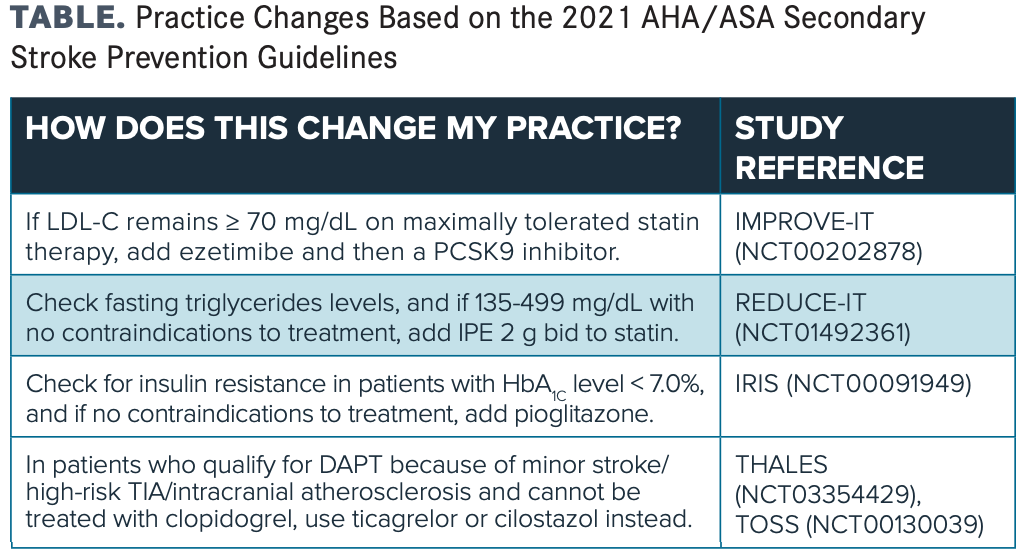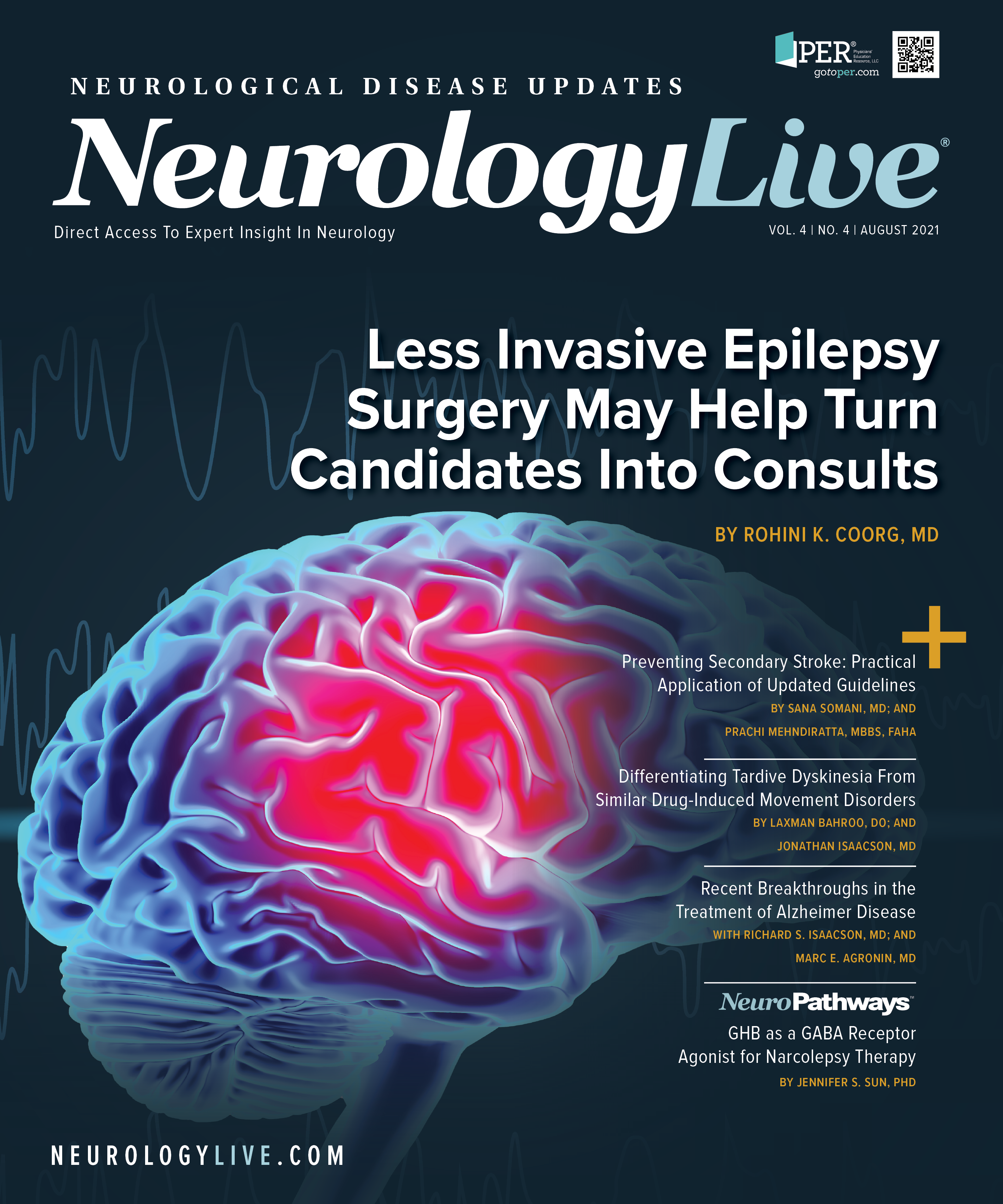Publication
Article
NeurologyLive
Preventing Secondary Stroke: Practical Application of Updated Guidelines
Experts provide a summary of the management of commonly encountered risk factors for secondary ischemic stroke and transient ischemic attack based on the newly published 2021 AHA/ASA recommendations.
Sana Somani, MD

STROKE CONTINUES TO BE THE fifth-leading cause of death in the United States.1 High blood pressure, diet, physical inactivity, smoking, and abdominal obesity were the top 5 risk factors associated with ischemic and hemorrhagic stroke incidence observed in the INTERSTROKE study.2 Targeting multiple risk factors has a combined benefit for secondary prevention— medications combined with diet modification and exercise can result in an 80% cumulative risk reduction in recurrent vascular events, according to findings from Hackam et al.3
The recent American Heart Association (AHA)/ American Stroke Association guideline on secondary stroke prevention provides comprehensive practical guidance for prevention of recurrent ischemic stroke and transient ischemic attack (TIA).4 The TABLE provides a few of the major practice changes based on the guidelines.
Physical Inactivity
The 2014 guidelines recommended that stroke survivors aim to achieve 40-minute sessions of moderate to vigorous intensity exercise at least 3 to 4 times a week.5 Emerging data from the SAMMPRIS trial (NCT00576693) have revealed benefit of intermittent, 10-minute bouts of moderate physical activity (sufficient to noticeably raise heart rate, like walking briskly) up to 4 times a week or 20-minute bouts of vigorous activity (like jogging) up to twice a week.6 This has now been added as a guideline recommendation for patients with stroke who are unable to achieve the prior recommendations.
AHA, American Heart Association; ASA, American Stroke Association; bid, twice a day; DAPT, dual antiplatelet therapy; HbA1C, glycated hemoglobin A1C; IPE, icosapent ethyl; LDL-C, low-density lipoprotein cholesterol; TIA, transient ischemic attack.

Substance Use
With the advent of new psychoactive substances and the legalization of marijuana in many states, recent studies have demonstrated an increased association of substance use with strokes.7-10 For patients with stroke or TIA who use stimulants (such as amphetamines, amphetamine derivatives, cocaine, or khat) and for patients with infective endocarditis with active intravenous drug use, health care providers should note that this behavior is a health risk and counsel them to stop. Although cannabis is not specifically mentioned in the above guideline, the CDC identified that young adults (aged 18-44 years) with recent cannabis use have higher odds of stroke compared with nonusers, which increases with frequent cannabis use (> 10 days/month).11
Hypertension
In 2017, the AHA/American College of Cardiology hypertension guideline defined hypertension as blood pressure consistently greater than 130/80 mm Hg.12 An independent Cochrane analysis and a large meta-analysis provided compelling evidence that neurologically stable patients with cerebrovascular disease also benefit from a blood pressure goal of less than 130/80 mm Hg.13,14 Target blood pressure for stroke prevention is now more aligned with cardiovascular targets.4 Current guidelines recommend a goal of less than 130/80 mm Hg in patients with recent stroke or TIA for prevention of recurrent events.
Prachi Mehndiratta, MBBS, FAHA

Hyperlipidemia and Hypertriglyceridemia
A secondary analysis of the IMPROVE-IT trial (NCT00202878) found a significantly lower risk of ischemic stroke with ezetimibe treatment (in addition to simvastatin) among patients with previous myocardial infarction (MI).15 Ezetimibe use before initiating a PCSK9 inhibitor is recommended because ezetimibe is available as a generic drug and has proven safety.16 This guideline strongly recommends that high-risk patients with atherosclerotic cardiovascular disease receive highintensity statin therapy and that if low-density lipoprotein cholesterol (LDL-C) level remains greater than or equal to 70 mg/dL on maximally tolerated statin therapy, it may be reasonable to add ezetimibe and then a PCSK9 inhibitor if necessary.
The REDUCE-IT trial (NCT01492361) revealed a 25% reduction in the primary end point of major adverse cardiovascular events in patients who were randomized to icosapent ethyl (IPE) 2 g twice daily plus statin therapy.17 A new recommendation is to include treatment with IPE in patients with ischemic stroke or TIA, with a fasting triglyceride level of 135 to 499 mg/dL and an LDL-C level of 41 to 100 mg/dL, on moderate or high-intensity statin therapy, with a glycated hemoglobin A1C (HbA1C) level of less than 10% and no history of pancreatitis, atrial fibrillation (AF), or severe heart failure to reduce risk of recurrent stroke.
Diabetes Mellitus
Although insulin resistance is not routinely evaluated in patients with stroke/TIA, the new guidelines mention that in patients 6 months or less after TIA or ischemic stroke with insulin resistance, HbA1C level less than 7.0%, and without heart failure or bladder cancer, treatment with pioglitazone may be considered to prevent recurrent stroke. This is based on results of the IRIS trial (NCT00091949), which examined the effect of pioglitazone compared with placebo among patients without diabetes who had a recent ischemic stroke and insulin resistance. After a mean of 3.8 years, a relative risk reduction of 24.0% was noted in recurrent stroke or MI compared with 11.8% among placebo recipients and 9.0% among pioglitazone recipients.18
Intracranial Atherosclerosis
The THALES trial (NCT03354429) demonstrated a reduced risk of recurrent stroke or death at 30 days among patients with greater than or equal to 30% intracranial stenosis ipsilateral to the ischemic event who were treated with ticagrelor and aspirin compared with aspirin alone (9.9% in ticagrelor + aspirin vs 15.2% aspirin alone).19 In this subgroup of patients with recent (within 24 hours) minor stroke or high-risk TIA and concomitant ipsilateral more than 30% stenosis of a major intracranial artery, the addition of ticagrelor 90 mg twice a day to aspirin for up to 30 days might be considered to further reduce recurrent stroke risk.
In patients with stroke or TIA attributable to 50% to 99% stenosis of a major intracranial artery, the addition of cilostazol 200 mg/day to aspirin or clopidogrel might be considered to reduce recurrent stroke risk. This new recommendation is based on the TOSS and TOSS-2 (NCT00130039) trials, which revealed that cilostazol plus aspirin was as safe as aspirin alone or clopidogrel plus aspirin with no added benefit for stroke prevention in this subgroup.20,21 Cilostazol can hence be considered especially in patients who are unable to respond to or tolerate clopidogrel.
Atrial Fibrillation
The improved safety profile of direct oral anticoagulants (DOACs) with noninferior thromboembolic risk has led to the preferential use of a DOAC over warfarin.22 However, a subset of the patient population is still unable to tolerate any anticoagulation because of increased bleeding risk. Left atrial appendage occluders such as the Watchman have demonstrated nonsignificant numerically greater thrombotic risk with the device but lower bleeding risk and overall net benefit in recent trials.23 This evidence has led to a new recommendation for consideration of percutaneous closure of the left atrial appendage with the Watchman device to reduce the chance of recurrent stroke and bleeding in patients with stroke or TIA in the setting of nonvalvular AF who have contraindications for lifelong anticoagulation but can tolerate at least 45 days of blood thinners.
All DOAC medications are renally cleared, increasing the risk of drug accumulation and bleeding events in patients with renal failure.24 Although overall data are limited, a large retrospective study matched patients with AF on dialysis who took apixaban against patients taking warfarin and found a 28% lower rate of bleeding events in those taking apixaban,3 supporting its use as an alternative choice for anticoagulation in patients with AF on dialysis.
Patent Foramen Ovale Closure
Several studies have evaluated secondary stroke prevention of patent foramen ovale closure since the previous guideline in 2014.25-28 It is now considered reasonable to percutaneously close patent foramen ovale in patients who meet the following criteria: aged 18 to 60 years, nonlacunar stroke, absence of other identified cause, and a high-risk patent foramen ovale (larger shunt size, atrial septal aneurysm).
Embolic Stroke of Undetermined Source
The NAVIGATE ESUS (NCT02313909) and RE-SPECT ESUS (NCT02239120) randomized trials found no reduction in secondary stroke risk among patients with ischemic stroke or TIA who were treated with a direct oral anticoagulant compared with antiplatelets.29,30 Hence, in patients with embolic stroke of undetermined source, treatment with direct oral anticoagulants is not recommended to reduce the risk of secondary stroke.
The guideline also has added sections on specific rare disorders like antiphospholipid syndrome, hypercoagulable states, central nervous system and infectious vasculitis, carotid webs, fibromuscular dysplasia, and genetic disorders. Although guidelines are intended to define practices meeting the needs of patients in most circumstances, they should not replace clinical judgment; furthermore, the recommendations should be considered in the context of individual patient laboratory values, preferences, and associated conditions.4
REFERENCES
1. CDC WONDER Database. Centers for Disease Control and Prevention, National Center for Health Statistics. Published 2020. Accessed July 21, 2021. http://wonder.cdc.gov/ucd-icd10.html
2. O’Donnell MJ, Xavier D, Liu L, et al; INTERSTROKE Investigators. Risk factors for ischaemic and intracerebral haemorrhagic stroke in 22 countries (the INTERSTROKE study): a case-control study. Lancet. 2010;376(9735):112-123. doi:10.1016/S0140-6736(10)60834-3
3. Hackam DG, Spence JD. Combining multiple approaches for the secondary prevention of vascular events after stroke: a quantitative modeling study. Stroke. 2007;38(6):1881-1885. doi:10.1161/STROKEAHA.106.475525
4. Kleindorfer DO, Towfighi A, Chaturvedi S, et al. 2021 Guideline for the prevention of stroke in patients with stroke and transient ischemic attack: a guideline from the American Heart Association/American Stroke Association. Stroke. 2021;52(7):e364-e467. doi:10.1161/STR.0000000000000375
5. Kernan WN, Ovbiagele B, Black HR, et al; American Heart Association Stroke Council, Council on Cardiovascular and Stroke Nursing, Council on Clinical Cardiology, and Council on Peripheral Vascular Disease. Guidelines for the prevention of stroke in patients with stroke and transient ischemic attack: a guideline for healthcare professionals from the American Heart Association/American Stroke Association. Stroke. 2014;45(7):2160-2236. doi:10.1161/STR.0000000000000024
6. Turan TN, Nizam A, Lynn MJ, et al. Relationship between risk factor control and vascular events in the SAMMPRIS trial. Neurology. 2017;88(4):379-385. doi:10.1212/WNL.0000000000003534
7. Ali WM, Zubaid M, Al-Motarreb A, et al. Association of khat chewing with increased risk of stroke and death in patients presenting with acute coronary syndrome. Mayo Clin Proc. 2010;85(11):974-980. doi:10.4065/mcp.2010.0398
8. Habel LA, Cooper WO, Sox CM, et al. ADHD medications and risk of serious cardiovascular events in young and middle-aged adults. JAMA. 2011;306(24):2673-2683. doi:10.1001/jama.2011.1830
9. Westover AN, McBride S, Haley RW. Stroke in young adults who abuse amphetamines or cocaine: a population-based study of hospitalized patients. Arch Gen Psychiatry. 2007;64(4):495-502. doi:10.1001/archpsyc.64.4.495
10. Petitti DB, Sidney S, Quesenberry C, Bernstein A. Stroke and cocaine or amphetamine use. Epidemiology. 1998;9(6):596-600.
11. Parekh T, Pemmasani S, Desai R. Marijuana use among young adults (18-44 years of age) and risk of stroke: a behavioral risk factor surveillance system survey analysis. Stroke. 2020;51(1):308-310. doi:10.1161/STROKEAHA.119.027828
12. Whelton PK, Carey RM, Aronow WS, et al. 2017 ACC/AHA/AAPA/ABC/ACPM/AGS/APhA/ASH/ASPC/NMA/PCNA guideline for the prevention, detection, evaluation, and management of high blood pressure in adults: executive summary: a report of the American College of Cardiology/American Heart Association Task Force on Clinical Practice Guidelines. Circulation. 2018;138(17):e426-e483. doi:10.1161/CIR.0000000000000597
13. Zonneveld TP, Richard E, Vergouwen MD, et al. Blood pressure-lowering treatment for preventing recurrent stroke, major vascular events, and dementia in patients with a history of stroke or transient ischaemic attack. Cochrane Database Syst Rev. 2018;7(7):CD007858. doi:10.1002/14651858.CD007858.pub2
14. Katsanos AH, Filippatou A, Manios E, et al. Blood pressure reduction and secondary stroke prevention: a systematic review and metaregression analysis of randomized clinical trials. Hypertension. 2017;69(1):171-179. doi:10.1161/HYPERTENSIONAHA.116.08485
15. Bohula EA, Wiviott SD, Giugliano RP, et al. Prevention of stroke with the addition of ezetimibe to statin therapy in patients with acute coronary syndrome in IMPROVE-IT (Improved Reduction of Outcomes: Vytorin Efficacy International Trial). Circulation. 2017;136(25):2440-2450. doi:10.1161/CIRCULATIONAHA.117.029095
16. Cannon CP, Blazing MA, Giugliano RP, et al; IMPROVE-IT Investigators. Ezetimibe added to statin therapy after acute coronary syndromes. N Engl J Med. 2015;372(25):2387-2397. doi:10.1056/NEJMoa1410489
17. Bhatt DL, Steg PG, Miller M, et al; REDUCE-IT Investigators. Cardiovascular risk reduction with icosapent ethyl for hypertriglyceridemia. N Engl J Med. 2019;380(1):11-22. doi:10.1056/NEJMoa1812792
18. Kernan WN, Viscoli CM, Furie KL, et al; IRIS Trial Investigators. Pioglitazone after ischemic stroke or transient ischemic attack. N Engl J Med. 2016;374(14):1321-1331. doi:10.1056/NEJMoa1506930
19. Amarenco P, Denison H, Evans SR, et al; THALES Steering Committee and Investigators. Ticagrelor added to aspirin in acute nonsevere ischemic stroke or transient ischemic attack of atherosclerotic origin. Stroke. 2020;51(12):3504-3513. doi:10.1161/STROKEAHA.120.032239
20. Kwon SU, Cho YJ, Koo JS, et al. Cilostazol prevents the progression of the symptomatic intracranial arterial stenosis: the multicenter double-blind placebo-controlled trial of cilostazol in symptomatic intracranial arterial stenosis. Stroke. 2005;36(4):782-786. doi:10.1161/01.STR.0000157667.06542.b7
21. Kwon SU, Hong KS, Kang DW, et al. Efficacy and safety of combination antiplatelet therapies in patients with symptomatic intracranial atherosclerotic stenosis. Stroke. 2011;42(10):2883-2890. doi:10.1161/STROKEAHA.110.609370
22. Ruff CT, Giugliano RP, Braunwald E, et al. Comparison of the efficacy and safety of new oral anticoagulants with warfarin in patients with atrial fibrillation: a meta-analysis of randomised trials. Lancet. 2014;383(9921):955-962. doi:10.1016/S0140-6736(13)62343-0
23. Reddy VY, Doshi SK, Kar S, et al; PREVAIL and PROTECT AF Investigators. 5-year outcomes after left atrial appendage closure: from the PREVAIL and PROTECT AF trials. J Am Coll Cardiol. 2017;70(24):2964-2975. doi:10.1016/j.jacc.2017.10.021
24. Siontis KC, Zhang X, Eckard A, et al. Outcomes associated with apixaban use in patients with end-stage kidney disease and atrial fibrillation in the United States. Circulation. 2018;138(15):1519-1529. doi:10.1161/CIRCULATIONAHA.118.035418
25. Mas JL, Derumeaux G, Guillon B, et al; CLOSE Investigators. Patent foramen ovale closure or anticoagulation vs. antiplatelets after stroke. N Engl J Med. 2017;377(11):1011-1021. doi:10.1056/NEJMoa1705915
26. Saver JL, Carroll JD, Thaler DE, et al; RESPECT Investigators. Long-term outcomes of patent foramen ovale closure or medical therapy after stroke. N Engl J Med. 2017;377(11):1022-1032. doi:10.1056/NEJMoa1610057
27. Søndergaard L, Kasner SE, Rhodes JF, et al; Gore REDUCE Clinical Study Investigators. Patent foramen ovale closure or antiplatelet therapy for cryptogenic stroke. N Engl J Med. 2017;377(11):1033-1042. doi:10.1056/NEJMoa1707404
28. Mas JL, Derex L, Guérin P, et al. Transcatheter closure of patent foramen ovale to prevent stroke recurrence in patients with otherwise unexplained ischaemic stroke: expert consensus of the French Neurovascular Society and the French Society of Cardiology. 2019;112(8-9):532-542. doi: 10.1016/j.acvd.2019.06.002
29. Hart RG, Sharma M, Mundl H, et al; NAVIGATE ESUS Investigators. Rivaroxaban for stroke prevention after embolic stroke of undetermined source. N Engl J Med. 2018;378(23):2191-2201. doi:10.1056/NEJMoa1802686
30. Diener HC, Sacco RL, Easton JD, et al; RE-SPECT ESUS Steering Committee and Investigators. Dabigatran for prevention of stroke after embolic stroke of undetermined source. N Engl J Med. 2019;380(20):1906-1917. doi:10.1056/NEJMoa1813959






